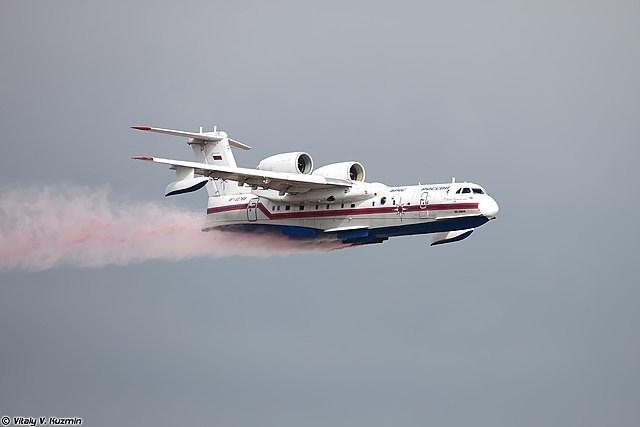Be-200
Summary
| Category | Military Transport Aircraft |
| Origin country | 🇷🇺 Russia |
| Manufacturer | Beriev |
| First flight | 24 September 1998 |
| Year introduced | 2003 |
| Number produced | 19 units |
| Average unit price | $67 million |
Description
Initiated in 1989 under the design leadership of Alexander Yavkin, the Be-200 aimed to fulfill a need for a civilian flying boat smaller than Beriev's existing military A-40, sharing a similar layout but designed to be approximately half the weight. The Russian government granted approval for the purpose-designed water bomber on 8 December 1990, and details were unveiled at the 1991 Paris Air Show. Due to financial constraints, Beriev partnered with the Irkutsk Aircraft Production Association to develop and construct the Be-200. Beriev handled development, design, documentation, testing, certification, and support, while Irkut focused on production preparation, tooling manufacture, prototype production, and spare parts. Beriev developed unique fire-fighting equipment, enabling water scooping at high speeds, which was tested on a modified Be-12P. The first land-based flight occurred on September 24, 1998, followed by the first water takeoff on September 10, 1999, in Taganrog.
The Be-200 is a T-tailed high-wing monoplane featuring a single-step hull with a high length-to-beam ratio designed for stability and control on water. Its airframe is primarily constructed from aluminum alloys treated for corrosion protection, with selective use of titanium, composites, and other corrosion-resistant materials. Underwing stabilizer floats are fitted to the wings, and a water rudder provides steering when afloat. Hydraulically operated, retractable twin-wheel landing gear units retract rearward for land operations. Power is provided by two pylon-mounted Progress D-436TP engines, specifically designed as corrosion-resistant versions of the D-436 three-shaft turbofan, positioned above the wingroot pods to avoid water ingestion. The digital fly-by-wire cockpit incorporates navigation systems including satellite navigation, FMS, autopilot, and weather radar. The ARIA 200-M all-weather integrated avionics system, developed by Honeywell and the Moscow Research Institute of Aircraft Equipment, presents information to the two-person crew via six LCD screens. The cabin is pressurized and air-conditioned.
The Be-200 is primarily designed for firefighting, utilizing eight internal ferric aluminum alloy water tanks located beneath the cabin floor, capable of holding up to 12,000 kg (26,000 lb) of water or retardant. It features four retractable water scoops—two forward and two aft of the fuselage step—allowing it to scoop up to 12 tonnes of water in approximately 14 seconds while skimming the water surface at high speed. Alternatively, the tanks can be filled from a hydrant or cistern on the ground. The aircraft can release the water in a single drop or in up to eight consecutive drops. It also carries six auxiliary tanks with a total capacity of 1.2 m3 for fire-retarding chemical agents. The water tanks can be quickly removed for cargo transport, accommodating a payload of up to 7,500 kg (16,500 lb). The aircraft can also be configured for passenger transport, capable of accommodating up to 72 passengers.
The Be-200 has been operationally deployed in various regions for firefighting and search and rescue. Documented deployments include Sardinia, Italy (2004), Portugal (2006), Indonesia (2006, search and rescue following Indonesia AirAsia Flight 8501 loss), Greece (2007), Russia (2010 wildfires), Israel (2010 Mount Carmel forest fire), and Turkey (firefighting and search and rescue). Azerbaijan became a foreign customer in 2008, utilizing the Be-200ES. An incident occurred in Portugal in 2006 involving engine contact with trees during water pickup. A Be-200 crashed in Turkey in August 2021 during firefighting operations. The aircraft's European certification was revoked on 14 March 2022.
Main Variants:
-
Be-200: The basic multirole model serves as the foundation for subsequent variants, offering versatility in various operational roles.
-
Be-200ChS/Be-200ES: This is a multirole model tailored to meet the specific requirements of the Russian Ministry of Emergency Situations, enhancing its capabilities for emergency response and disaster relief.
-
Be-200E: An adaptation of the Be-200ES, this version features an English cockpit, likely aimed at improving usability for international operators and pilots.
-
Be-200RR: This was a projected variant intended to be powered by Rolls-Royce engines; however, the project has since been shelved.
-
Be-210: This projected passenger-only model was envisioned as a dedicated transport aircraft, maximizing passenger capacity.
Technical specifications
| Version: Be-200ChS | |
|---|---|
| Maximum speed | 700 km/h (435 mph) |
| Wing area | 117.4 m² (1263.7 sqft) |
| Wingspan | 32.8 m (107.5 ft) |
| Height | 8.9 m (29.2 ft) |
| Length | 31.4 m (103.1 ft) |
| Service ceiling | 8,000 m (26,247 ft) |
| Empty weight | 27,600 kg (60,848 lbs) |
| Max. takeoff weight | 41,000 kg (90,389 lbs) |
| Climb rate | 17.0 m/s (55.8 ft/s) |
| Takeoff distance | 1,800 m (5,906 ft) |
| Powerplant | 2 x turbojets Ivchenko-Progress D-436TP delivering 7500 kgf each |
Current operating countries
| Country | Units | ||
|---|---|---|---|

|
Russia | 2 | |
All operators

